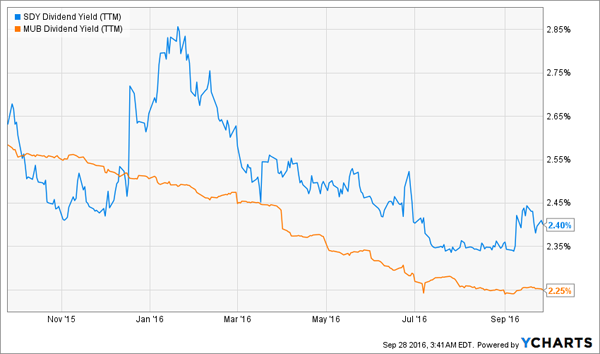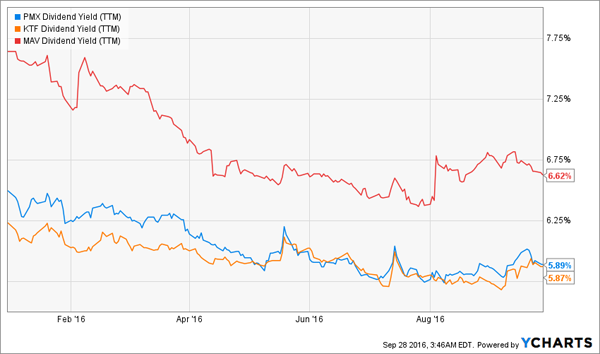Taxes can eat up investing returns. Anyone who’s bought stocks and filled in a tax form knows this. But you don’t need to pay taxes on your investments—in fact, you can get a higher stream of income without paying any taxes altogether. The secret: municipal bond funds.
This is especially important if you’re in the 25% income tax bracket or higher—and if you’re earning over $36,900, that means you.
[ad#Google Adsense 336×280-IA]You can use the IRS’s calculator to calculate your tax obligations, or there’s Paycheck City’s really easy and fast calculator if you want to look at state taxes, too.
Let’s see how municipal bond funds can provide a married couple—we’ll call them John and Jane Doe—with more income immediately thanks to less tax obligations.
To do this, we’ll focus on dividends.
John and Jane want to earn as much passive income with as little risk as possible, which probably means they’ll be interested in the SPDR S&P Dividend Fund (SDY), currently yielding 2.4%.
That’s not much, but better than any savings account or a long-term Treasury. Unfortunately, SDY’s dividend yield has been going down:
Less and Less Income for Retirees
 One side effect of this trend is that it’s making municipal bonds more attractive. Since they’re tax free, munis are now offering a higher income stream net of taxes. That’s why John and Jane would actually be better off buying the iShares National Municipal Bond fund (MUB):
One side effect of this trend is that it’s making municipal bonds more attractive. Since they’re tax free, munis are now offering a higher income stream net of taxes. That’s why John and Jane would actually be better off buying the iShares National Municipal Bond fund (MUB):
Weak Stock Dividends Make Munis Attractive
 The yields are close to each other now—but what does that mean in practice?
The yields are close to each other now—but what does that mean in practice?
Let’s assume that our hypothetical married couple earns more than $73,800 per year in total and they have $500,000 saved up. This means they’re in the 25% income tax bracket, and they will have to pay 15% taxes on the dividends that SDY pays. Keep in mind these are only federal taxes—if you pay state taxes, you will likely have to fork over even more of your dividend income to your state. With a $500,000 investment in SDY, that means an annual tax bill of $1,800 on gross dividend income of $12,000. Your cash in hand will be just $10,200, or $850 per month.
If the couple put that money in MUB instead, there’d be no tax bill at all on their dividends, which will total $11,250. That’s $937.50 per month.
This is how powerful tax-free distributions can be. But can you live on just $937.50 per month? No thanks.
Instead of being satisfied with this payout, let’s find a better yielding municipal bond fund to get tax-free income. This way, we can get even closer to being fully financially independent and avoiding taxes altogether.
Fortunately, there are plenty of options. Here are three.
First, there’s the Pimco Municipal Income III (PMX), which pays a 5.9% dividend. To diversify, let’s add the Deutsche Municipal Income Fund (KTF) and the Pioneer Municipal High Income Advantage Fund (MAV). These are funds with strong distribution histories and good access to the municipal credit markets. They also pay great dividends:
High Dividends—and They’re Tax-Free, Too
 Now we’re talking! An average 6.1% dividend yield means John and Jane’s $500,000 portfolio is now paying $30,500 in tax-free income, or $2,541 per month.
Now we’re talking! An average 6.1% dividend yield means John and Jane’s $500,000 portfolio is now paying $30,500 in tax-free income, or $2,541 per month.
How does that compare to John and Jane’s wage-based income? Not bad, actually. Before taxes, they’re earning $6,150 per month—but after taxes they’re getting just $4,941. That means their tax-free income from these municipal bond funds is $2,400 short of what they’re getting from working.
It’s probably impossible for John and Jane to cut their expenses by over $28,000 per year, so they’re not ready for retirement quite yet. But they’re a lot closer than they thought.
— Brett Owens
Sponsored Link: On top of those municipal bond funds, there are a group of funds that pay 8% dividends per year. On a $500,000 investment, that’s $40,000 per year—or $1,608 per month less than John and Jane are making now by working. That’s still a lot of cost cutting, but not impossible. Oh, and taxes? Forget about it. If they can make the jump to not work and live on the passive income from their $500k portfolio, their tax rate on dividends will drop to 0% since they’re no longer in the 25% income tax bracket.
“Great deal, huh? This is just one of the many keys in building a “No Withdrawal Portfolio” that investors can use to boost their passive income and get a jump start into retirement. Since there is a group of funds that have stable 8% dividend yields thanks to savvy active management of high yielding, high quality assets, investors can now get the kind of returns that used to be available only to hedge funds and a savvy elite.
Oh, and hedge fund billionaires are starting to buy these funds, so the smart money knows it’s a good bet.
Want to learn more? I’ll show you exactly how these funds work, where to find them, and how to understand them – and reveal [more information] here.
Source: Contrarian Outlook
